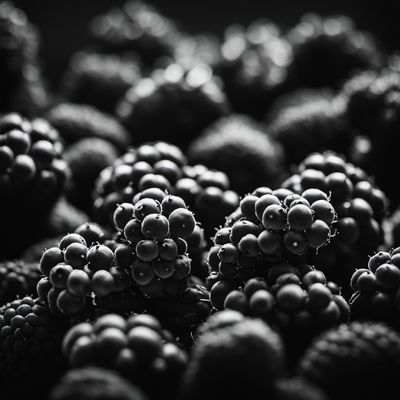
Ingredient
Mulberries (black and white) and similar-
Nature's Sweet and Juicy Gems
Mulberries are small to medium-sized berries with a plump and juicy texture. They can be black, white, or a combination of both colors. The flavor of mulberries is sweet with a hint of tartness, similar to a mix of blackberries and raspberries. These berries are often enjoyed fresh, but can also be used in jams, jellies, pies, and other desserts.
Origins and history
Mulberries have a long history and are believed to have originated in Asia. They have been cultivated for thousands of years and have played a significant role in various cultures and cuisines. Mulberries are highly regarded for their nutritional value and are enjoyed in many countries around the world.
Nutritional information
Mulberries are a good source of vitamin C, vitamin K, and dietary fiber. They are also rich in antioxidants, which help protect the body against oxidative stress. Mulberries are relatively low in calories and fat.
Allergens
May cause allergic reactions in individuals with sensitivities to berries.
How to select
When selecting mulberries, look for berries that are plump, firm, and evenly colored. Avoid berries that are overly soft, bruised, or have moldy spots. Fresh mulberries should have a sweet aroma. If purchasing dried mulberries, ensure they are free from clumps and have a chewy texture.
Storage recommendations
To maintain the freshness of mulberries, store them in the refrigerator in a breathable container or a perforated plastic bag. Use them within a few days to enjoy their optimal flavor and texture. Dried mulberries can be stored in an airtight container in a cool, dark place for several months.
How to produce
Mulberry trees can be grown in home gardens or larger orchards. They require well-drained soil and prefer full sun. Mulberry trees are relatively low-maintenance and can be propagated from cuttings or purchased as young saplings.
Preparation tips
Mulberries can be enjoyed fresh as a snack or incorporated into various dishes. They can be used in jams, jellies, pies, tarts, smoothies, and salads. Mulberries pair well with other fruits, yogurt, cheese, and chocolate. They can also be dried and used as a topping for cereals or baked goods.
Substitutions
Blackberries, raspberries, or blueberries can be used as substitutes for mulberries. These berries offer similar flavors and textures, making them suitable replacements in recipes.
Culinary uses
Mulberries are commonly used in desserts such as pies, tarts, and jams. They are also used in savory dishes, such as sauces for meats or salads. Mulberries are popular in countries such as Turkey, Iran, China, and the United States.
Availability
Mulberries are commonly available in regions where they are cultivated, including Asia, Europe, North America, and Australia.
